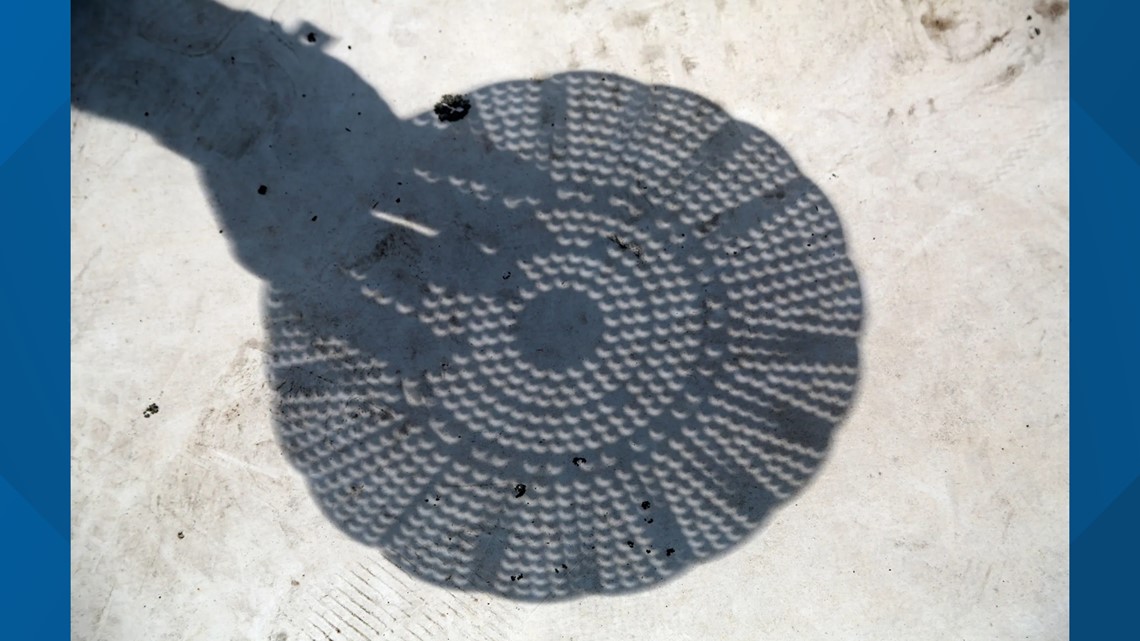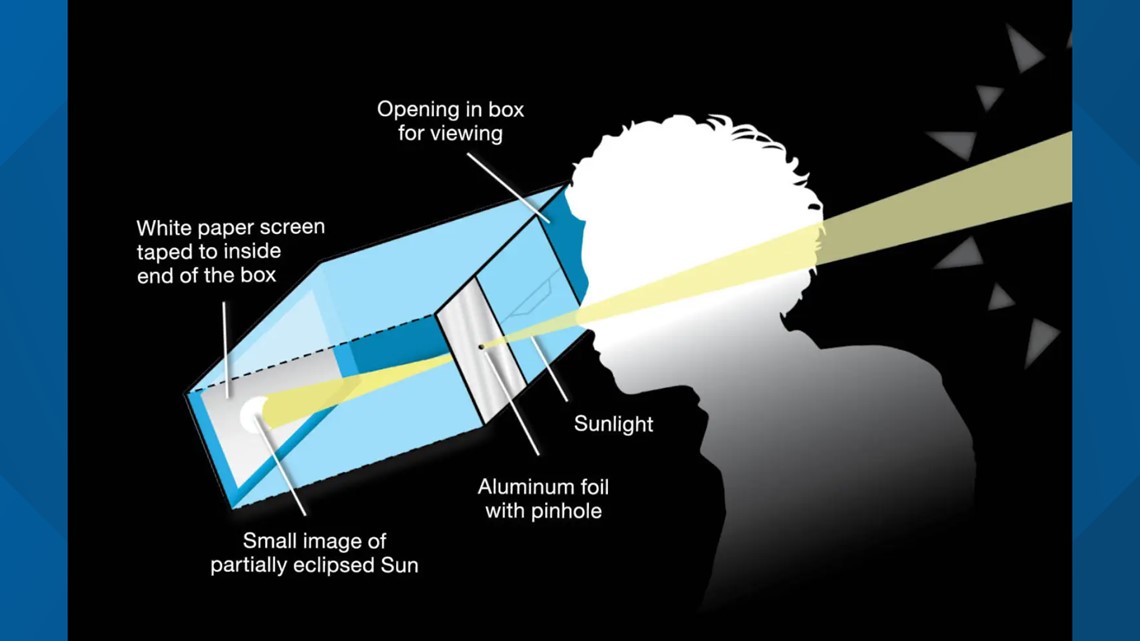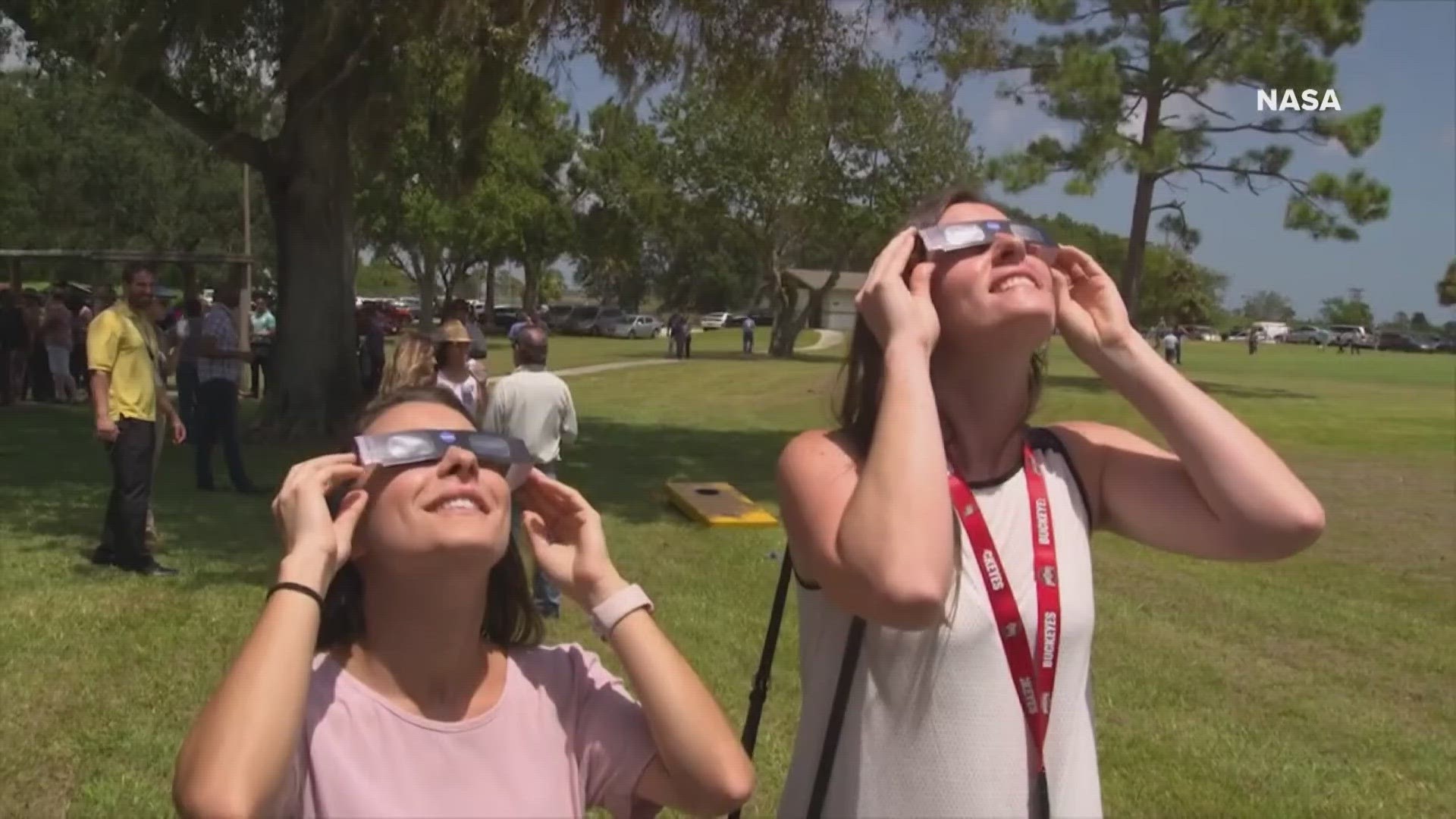TEXAS, USA — For the first time since 2012, a rare sight will be visible over North America on Oct. 14: an annular solar eclipse.
An annular eclipse, also known as a "ring of fire" eclipse, occurs when the moon is at or near its farthest point from Earth when it passes in front of the sun and does not quite cover the entire sun.
The result? The edges of the sun peek out from behind the moon, making it look like a ring of fire in the sky.
Much of Central Texas is set to be right in or near the prime viewing path of the eclipse, and people across the state are gearing up to get a glimpse of the rare phenomenon. When it comes to actually watching the annular eclipse, however, experts say it is important to do it safely.
As with any other time, it is not safe to look directly at the sun during an eclipse. Thankfully, NASA and the National Parks Service have a few suggestions on how to view the celestial sight.
Safe ways to watch the annular eclipse:
Eclipse glasses or solar viewers:
Both NASA and the National Parks Service say that the only way to safely view the eclipse directly is through specialized eye protection, such as "eclipse glasses" or handheld solar viewers.
Eclipse glasses can be worn similarly to regular glasses, while solar viewers can be held in front of the eyes.
Eclipse glasses are different from regular sunglasses, typically being thousands of times darker. NASA says any solar filters used to watch the eclipse should comply with the ISO 12312-2 international standard, and should not be damaged in any way.
The American Astronomical Society has a list of suppliers of solar viewers available on their website at this link, along with more information on how to determine if a solar viewer is safe.
Can't find eclipse glasses? Don't worry, NASA suggests numerous indirect methods to view the eclipse as well.
Pinhole Projection:
The simplest way to indirectly view an eclipse is through what NASA calls "pinhole projection".
Pinhole projection involves passing sunlight through a small opening to project a solar image onto a nearby surface.
Plenty of everyday objects can be used for pinhole projection, such as a pasta colander, an index card with a hole punched in it, or even the gaps between your own fingers.
Simply place your back towards the sun and let the light shine through the hole/holes, and it will project a small image of the eclipse on the ground.
Note: Do NOT look through the hole directly at the sun, only use it to project the light onto another surface.


Rear-screen projection:
NASA warns against using a telescope, binoculars, camera lens or any other optical device to view an eclipse, as it can burn through the filter and cause eye damage unless a specialized aperture filter is used.
However, some telescopes can be used to project an image of the eclipse onto another surface, such as a screen or a card, allowing multiple people to view it at the same time.
Instructions from NASA on how to make a homemade "sun funnel" attachment for a telescope can be found at this link,
Note: NASA only recommends this method for telescopes that can tolerate having full-strength sunlight pass through them, as the sun can damage the lens or the telescope itself. Telescopes should never be pointed at the sun or left out in the sun for long periods of time.
NASA recommends consulting an expert before using a solar filter with a telescope or other optical device to ensure that it is safe and effective.
Homemade eclipse projectors:
If you don't have access to a telescope to other fancy equipment, there is also an easy way to make a homemade eclipse projector using materials you may already have in your home.
All you need is a cardboard box, a white sheet of paper, tape, scissors and aluminum foil.
An eclipse projector works on the same principle as pinhole projection. To make one, tape a white piece of paper to the inside of a cardboard box. On the other side of the box, tape a piece of aluminum foil to the outside and punch a pinhole through the foil and box to create a small opening.
With your back facing towards the sun, hold the box so that the sunlight shines through the hole in the foil and onto the paper inside. Make another opening in the box to see through, and an image of the sun will be projected through the foil onto the paper in the box.
More instructions and methods to make a homemade projector can be found at this link.


How NOT to view the annular eclipse:
While there are several safe ways to view the eclipse, there are multiple methods circulating the internet that the National Parks Service says are NOT safe. Here are a few things to avoid when watching the eclipse.
With the naked eye:
Unlike a total solar eclipse, which the National Parks Service says is safe to view with the naked eye ONLY during the brief moment the sun is completely covered, there is no point during an annular eclipse that the sun is covered enough to safely look at with the naked eye.
Use eclipse glasses, solar viewers or one of the other methods listed above.
Welding masks/Goggles:
Since welding masks are designed to limit light, some people claim they can be used to safely look at an eclipse. The National Parks Service though, says experts suggest only #14 welder's glass and above is safe for solar viewing.
The Parks Service warns against viewing the eclipse through any kind of welding glass that you do not know the shade number of, especially as arc welders typically use glass with a shade number significantly less than the #14 filter.
It is also not safe to look at the eclipse through a telescope while wearing welding goggles. The National Parks Service says the only safe way to view the eclipse through a telescope or other device is with an approved solar filter.
Sunglasses:
No type of regular sunglasses are safe to view the eclipse or look directly at the sun, even for a brief moment, according to the Parks Service. The only type of glasses safe to view the sun through are specialized eclipse glasses.
Mylar:
Another method some claim is safe is to view the eclipse through a piece of mylar from a balloon, but the National Parks Service also warns against this.
The Parks Service says the coating of the mylar can be semi-porous and is not designed to look at eclipses.
Cameras, phones, telescopes, binoculars, etc.:
NASA and the National Parks Service say it is not safe to view the eclipse through a camera, phone, telescope, or any other kind of optical device unless it is equipped with a specialized solar filter, as it can damage both your eyes and the device.
More information on the annular eclipse, including when and where to see it, can be found at this link.
More from 6 News:

